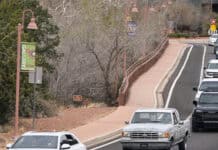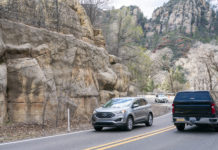The speed limit on the “corridor” of Highway 89A in West Sedona is being reduced.
The speed limit between Airport Road and Dry Creek Road will drop from 40 mph to 35 mph shortly after the Fourth of July, according to Arizona Department of Transportation Traffic Engineer Chuck Gillick.
The move came about after the city of Sedona expressed a concern to ADOT in 2006, regarding several fatal vehicle/pedestrian accidents along Highway 89A in West Sedona.
By Alison Ecklund
Larson Newspapers
The speed limit on the “corridor” of Highway 89A in West Sedona is being reduced.
The speed limit between Airport Road and Dry Creek Road will drop from 40 mph to 35 mph shortly after the Fourth of July, according to Arizona Department of Transportation Traffic Engineer Chuck Gillick.
The move came about after the city of Sedona expressed a concern to ADOT in 2006, regarding several fatal vehicle/pedestrian accidents along Highway 89A in West Sedona.
In August 2007, ADOT proposed to Sedona City Council 76 streetlights along Highway 89A, but residents expressed such concern and displeasure with the lighting proposal, council requested the formation of the SR89A Pedestrian Safety Committee to further study the problem.
On June 10, the safety committee presented council with 17 recommendations for increased safety on Highway 89A. Council approved all six short-term recommendations and installation of a stoplight at Andante Drive, by a vote of 5-2.
The first short-term option recommended by the committee was to reduce the speed limit from 40 mph to 35 mph between Airport Road and Dry Creek Road, “with the assistance
of ‘your speed is’ electronic warning signs.”
Although ADOT controls everything on state highways, including the speed, it is listening to the committee’s recommendation.
According to Gillick, reducing a speed limit is common.
About four years ago, ADOT reduced the speed limit on Highway 179 in the Village of Oak Creek from 40 mph to 35 mph.
The reduction came because of the large amount of side friction — areas to pull on or off the highway — which creates the potential for fender-benders and rear-end accidents, Gillick said.
ADOT hopes to make the speed reduction more effective by accompanying it with electronic speed signs that show the vehicles’ speed and photo enforcement that can catch speeders and issue tickets without the presence of law enforcement, Gillick said.
When the speed limit changes sometime in July, the Sedona Police Department will continue to enforce in the manner they do now, SPD Cmdr. Ron Wheeler said.
“We hope when it does change, there will be time to inform people,” he said. “There will be a learning curve; some will still be traveling 40 [mph].”
To deal with the learning curve, the police department will initiate a “crawl, walk, run” policy, motor officer Karl Waak said.
Officers might be a little softer at first — issuing warnings instead of tickets, he said.
And people can expect to see an increase in police presence on the highway, Wheeler warned.
It helps to do saturation at first, Waak agreed — stop a lot of people right away, to get the message out.
Normally there are two motorcycles on patrol in the “corridor,” but during a saturation period, as many as six officers may be patrolling the strip at once, Wheeler said.
“For the first couple of weeks, we’ll go out and show a high visibility,” he said, although he still expects to see speeders long after new signs are posted.
“It doesn’t matter what speed we set it at,” Wheeler said. “People will speed.”
Alison Ecklund can be reached at 282-7795, Ext. 125, or e-mail
aecklund@larsonnewspapers.com





















